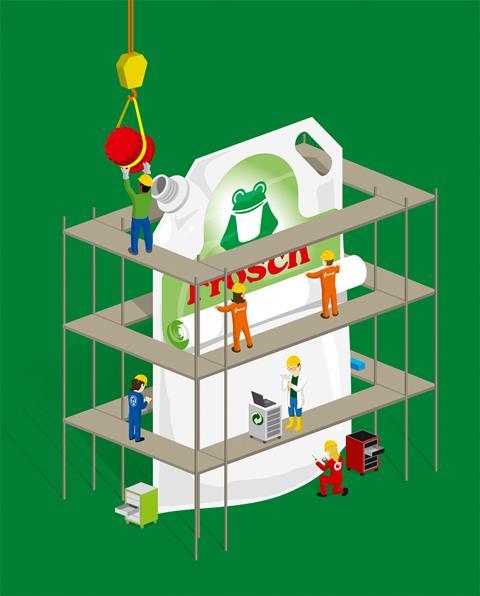
Werner & Mertz, Mondi, EPEA Switzerland, Der Grüne Punkt–DSD, cyclos-HTP and the quest to create cradle-to-cradle packaging.
It’s not easy being green – or circular – but by turning the traditional model of product design on its head, Mondi Group and Werner & Mertz GmbH, a German maker of cleaning products, have pioneered a new approach, developing a fully recyclable flexible, mono-material package for Werner & Mertz’s Frosch-brand detergent products. However, the brand owner and packaging supplier recognised they couldn’t achieve this on their own, so they enlisted three additional partners to support their mission. EPEA Switzerland GmbH, accredited general assessors for the Cradle to Cradle Certified™ certification, joined the project team to assess the quality of different materials that are designed for circular cycles, recyclable at a chemistry level. Secondly, Institut cyclos-HTP, the Institute for Recyclability and Product Responsibility, ensured that those materials would work within existing recycling structures and throughout their extended lifecycle. Finally, Der Grüne Punkt – Duales System Deutschland researched and confirmed the potential market value of the resulting recycled materials.
By working collaboratively for nearly four years, the team explored the theory and laid the groundwork for creating a 100 per cent recyclable, stand-up pouch. As a result, this new pouch – with its easily detachable decorative panels – will be certified under the strict Cradle to Cradle Certified™ guidelines.
Beginning in 2019, after adopting the ‘recipe’, Werner & Mertz and Mondi will advance these concepts from the drawing board to the ‘kitchen’ and begin to produce the pouch on new manufacturing assets acquired by Mondi specifically for this project.
Albin Kälin, CEO of EPEA Switzerland, described the innovation process employed for W&M’s new Frosch pouch as “fairly radical.” It involved “learning by doing and has never been done in this way,” said Kälin, who has two decades of Cradle to Cradle experience and a seasoned perspective on such matters. In 2009, he founded EPEA Switzerland, one of 15 firms worldwide that are accredited general assessors for the Cradle to Cradle Certified™ certification.
“This project is a lighthouse for all industries for how new products can be created,” he stated. That said, the Cradle to Cradle, or C2C, design approach is hardly new. German chemist Dr Michael Braungart and American architect William McDonough, working with the scientists of EPEA Internationale Umweltforschung in Hamburg, first devised the concept back in the 1990s to help drive a more circular, sustainable economy.
The traditional ‘Cradle to Grave’ approach to product lifecycles is a linear concept and leads to needless waste at the end of the cycle. The Cradle to Cradle approach is circular in nature, and requires a whole new, open-minded approach to product design. Waste materials in an old product become the ‘food’ for a new product. The goal is to allow materials to be used over and over again instead of being downcycled into lesser products, and eventually becoming waste.
According to Albin Kälin, most companies nevertheless struggle with effective implementation of this nature-inspired concept. “Very few companies ‘get it’ the way Werner & Mertz and Mondi did,” he remarked.
Family-run Werner & Mertz GmbH, founded in 1867 in Mainz, Germany, sought to integrate this approach into their products and packaging. In 2014 after other suppliers told them their ambition was not achievable, at least on the packaging end, they approached the multinational packaging and paper company Mondi.
Together they set out to reverse engineer the recycling process. They aimed for packaging fit for every stage of the process – in particular the often-problematic waste-sorting process. Contaminated recycling streams, including those that mix different, incompatible types of plastics, inevitably lead to materials with degraded properties that can only be downcycled into less-demanding end-use applications. Clean recycling streams offer the opportunity for more circular solutions with significantly extended longevity.
Achievement often falls short of the lofty talk we hear of collaboration around circularity. One key, noted Immo Sander, head of packaging development for Werner & Mertz, is to ensure that all partners fully aligned on strategy, goals, and roles and responsibilities.
Sustainable development is not a “plug-and-play” exercise, Sander continued, “Everyone must depart from the status quo and accept that risk is a necessary condition for serious technological advancement. If you want to develop something new, you have to be willing to put in hard work, to leap the hurdles of ‘restrictive thinking’.”
Jens Kösters, manager of technical services for Mondi Consumer Goods Packaging, elaborated: “We worked our way through an innovation funnel – testing different materials until we arrived at a designed-for-recycling concept that convinced everyone at each point of the value chain.”
The first step was determining, down to a molecular level, which materials would be environmentally acceptable and suitably recyclable for the desired end product. EPEA Switzerland defined every aspect of the potential package, including the resin, inks and constituent components of those materials for the future scientific assessment.
Next the Aachen-based cyclos-HTP offered its expertise on whether existing recycling structures were in place to accommodate the preferred materials, and whether they could handle these materials throughout their extended lifecycles. The group helps define which materials are suitable for recycling by colour-coding them (those tagged as green are good to recycle, orange OK, and red not recyclable).
After all, it’s one thing to be recyclable (as in being physically possible to be recycled), and another altogether to be recycled (with the necessary collection and sorting infrastructure, as well as appropriate economic feasibility) to ensure that such recycling actually gets done. Werner & Mertz wanted a real solution, not just a package that they could claim was ‘more sustainable’ but then still ended up in a landfill or incineration.

All packaging, explained Joachim Christiani, co-managing director of cyclos-HTP, has to be able to make it through a complex sorting process – identifiable via infrared scanning. Flexible packaging, which often features multilayer constructions of differing, incompatible materials, tends to be the one of the more problematic types of packaging when it comes to recycling. His firm weighed in early with suggestions on package design, appropriate materials to use, and the availability of sorting and recycling facilities in Europe.
Those involved also needed to resolve the issue of recycling printed plastic materials. This consideration led to what is perhaps the product’s most groundbreaking innovation, the two-layer construction: the pouch itself and the detachable, printed panels that proclaim the brand details on the front and necessary consumer information on the back.
“We dress the main body up in an eye-catching outer garment to give it shelf appeal,” noted Werner & Mertz CEO Reinhard Schneider. “And when the pouch is empty, we ‘undress’ it automatically by shredding and sorting the two components into separate recycling streams.”
Roughly 85 per cent of the total packaging material (low-density polyethylene, or LDPE), including spout and cap, is unprinted. This means the transparent material can be recycled without degradation of quality. The remaining 15 per cent is still fully recyclable, since the material is free of glues or adhesives, and can enjoy new life in other applications.
Schneider noted there are additional sustainability benefits. The spouted pouch, complete with die-cut handle, uses approximately 70 per cent less material than rigid plastic bottles that hold the same volume.
Once the project’s partners had determined a suitable design and the product’s preferred materials, Der Grüne Punkt looked at the potential end uses and true market value of such recycled materials – again to ensure that a viable economic reality existed to support the planned product.
And even once a product is designed and developed, the effort still is not finished. It then needs to be vetted and C2C certified by an appropriate organisation such as EPEA Switzerland. (C2CC product certification is now overseen by an independent non-profit called the Cradle to Cradle Products Innovation Institute, based in Oakland, California.)
Christiani noted that what made this project exceptional was how all relevant parties were involved from the beginning – the brand owner, the packaging producer, the waste material collector and sorter, the recycler and the C2CC accredited assessor – and were consulted at every step of the product development process.
“Mondi and W&M were trustworthy and highly competent during this project,” he said. “They are pioneers in developing sustainable flexible packaging.”
Dr Markus Helftewes, managing director of Germany-based Der Grüne Punkt, added that the cooperation between the five partners involved in this project offer “a good example of the progress that can be made.” Never has such commitment and progress been so important, as the world is publicly awash in plastic waste and seeking scalable solutions to address this pressing environmental issue.
One key approach is “to close the circle,” he explained, “so that packaging can be turned back into high-performance packaging again. The C2C approach, Helftewes stressed, is a vital step toward saving resources and reducing unnecessary waste.
For his part, EPEA Switzerland’s Albin Kälin pointed out that Mondi was extremely open-minded throughout the entire process and willing to adapt its production set-up to a new approach. This requires a significant level of commitment, and “is really unique,” he said. “Werner & Mertz and Mondi are role models not just for the packaging industry, but for all industries who want shift from cradle-to-grave to cradle-to-cradle lifecycles for their products. Of course, every industry that can do this, should.”
“One company cannot do this alone anymore,” he concluded. “You need an innovative design and a network of experts to create products for a circular economy. We have to remake everything that we make today – and Mondi and Werner & Mertz were up for the challenge.”

















